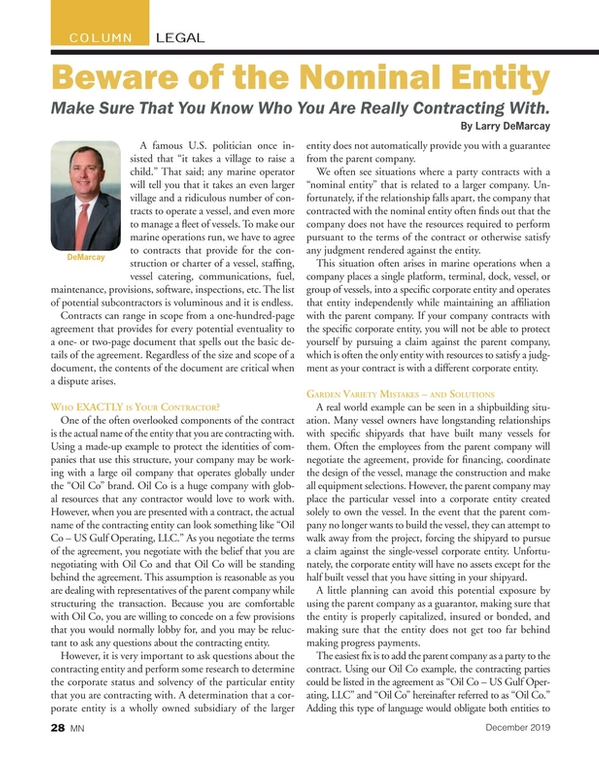
Beware of the Nominal Entity
Make sure you know who you are really contracting with.
A famous U.S. politician once insisted that “it takes a village to raise a child.” That said, any marine operator will tell you that it takes an even larger village and a ridiculous number of contracts to operate a vessel, and even more to manage a fleet of vessels. To make our marine operations run, we have to agree to contracts that provide for the construction or charter of a vessel, staffing, vessel catering, communications, fuel, maintenance, provisions, software, inspections, etc. The list of potential subcontractors is voluminous and it is endless.
Contracts can range in scope from a one-hundred-page agreement that provides for every potential eventuality to a one- or two-page document that spells out the basic details of the agreement. Regardless of the size and scope of a document, the contents of the document are critical when a dispute arises.
Who EXACTLY is Your Contractor?
One of the often overlooked components of the contract is the actual name of the entity that you are contracting with. Using a made-up example to protect the identities of companies that use this structure, your company may be working with a large oil company that operates globally under the “Oil Co” brand. Oil Co is a huge company with global resources that any contractor would love to work with. However, when you are presented with a contract, the actual name of the contracting entity can look something like “Oil Co – US Gulf Operating, LLC.” As you negotiate the terms of the agreement, you negotiate with the belief that you are negotiating with Oil Co and that Oil Co will be standing behind the agreement. This assumption is reasonable as you are dealing with representatives of the parent company while structuring the transaction. Because you are comfortable with Oil Co, you are willing to concede on a few provisions that you would normally lobby for, and you may be reluctant to ask any questions about the contracting entity.
However, it is very important to ask questions about the contracting entity and perform some research to determine the corporate status and solvency of the particular entity that you are contracting with. A determination that a corporate entity is a wholly owned subsidiary of the larger entity does not automatically provide you with a guarantee from the parent company.
We often see situations where a party contracts with a “nominal entity” that is related to a larger company. Unfortunately, if the relationship falls apart, the company that contracted with the nominal entity often finds out that the company does not have the resources required to perform pursuant to the terms of the contract or otherwise satisfy any judgment rendered against the entity.
This situation often arises in marine operations when a company places a single platform, terminal, dock, vessel, or group of vessels, into a specific corporate entity and operates that entity independently while maintaining an affiliation with the parent company. If your company contracts with the specific corporate entity, you will not be able to protect yourself by pursuing a claim against the parent company, which is often the only entity with resources to satisfy a judgment as your contract is with a different corporate entity.
Garden Variety Mistakes – and Solutions
A real world example can be seen in a shipbuilding situation. Many vessel owners have longstanding relationships with specific shipyards that have built many vessels for them. Often the employees from the parent company will negotiate the agreement, provide for financing, coordinate the design of the vessel, manage the construction and make all equipment selections. However, the parent company may place the particular vessel into a corporate entity created solely to own the vessel. In the event that the parent company no longer wants to build the vessel, they can attempt to walk away from the project, forcing the shipyard to pursue a claim against the single-vessel corporate entity. Unfortunately, the corporate entity will have no assets except for the half built vessel that you have sitting in your shipyard.
A little planning can avoid this potential exposure by using the parent company as a guarantor, making sure that the entity is properly capitalized, insured or bonded, and making sure that the entity does not get too far behind making progress payments.
The easiest fix is to add the parent company as a party to the contract. Using our Oil Co example, the contracting parties could be listed in the agreement as “Oil Co – US Gulf Operating, LLC” and “Oil Co” hereinafter referred to as “Oil Co.” Adding this type of language would obligate both entities to the terms of the contract, providing you with an additional layer of protection.
If the company is not willing to add the parent company as a party to the agreement, you could add a provision where the parent company agrees to guarantee the contractual obligation in the event of a breach of contract by the subsidiary. If such a provision is added, a representative from the parent company must sign the agreement accepting such responsibility.
The risks of dealing with an ‘assetless’ corporate entity could be alleviated by adding contractual language that forces the corporate entity to procure adequate insurance or a bond that would cover the company’s liabilities or guarantee the company’s performance under the contract. Under this scenario, the insurer would be available to satisfy any liabilities that may arise or the bonding company could be called upon to guarantee the company’s performance under the contract.
All is not lost if you have a claim against an assetless corporate entity. You can still pursue a claim against the parent company by attempting to pierce the parent company’s corporate veil of protection. You can argue that your day-to-day dealings were with the parent company’s employees, the parent company provided financing, the parent company supplied owner supplied equipment, etc. If you can paint a picture showing that the parent company was attempting to use the shell of an assetless corporate entity simply to protect itself from liability while failing to operate the entity as a separate corporate entity, you have a chance to make the parent company satisfy a claim.
Unfortunately, the need to pierce the corporate veil of a parent company complicates your litigation strategy making the pursuit of a claim against the parent company significantly more difficult, risky and expensive. Nevertheless, the risk of contracting with a separate corporate entity or subsidiary can be eliminated by spending a little time while negotiating the contract to make sure that the company has the resources needed to satisfy the obligations of the contract and that it is not simply a shell company that will leave you holding the bag if the relationship falls apart.
Read Beware of the Nominal Entity in Pdf, Flash or Html5 edition of December 2019 Marine News
Other stories from December 2019 issue
Content
- INSIGHTS: Niels Aalund page: 14
- Op/Ed: What Good Boats Can Do page: 22
- The Good, the Bad and the Undeniably Ugly page: 24
- The Mighty Mississippi: Taming the Bull page: 26
- Beware of the Nominal Entity page: 28
- It’s Time to Upgrade to a Marine Evacuation System page: 30
- NOx Control: Should Certain Vessels Get a Break? page: 34
- The Top 10 Workboat Stories for 2019 page: 36
- For Fireboats, The Heat is On page: 46


